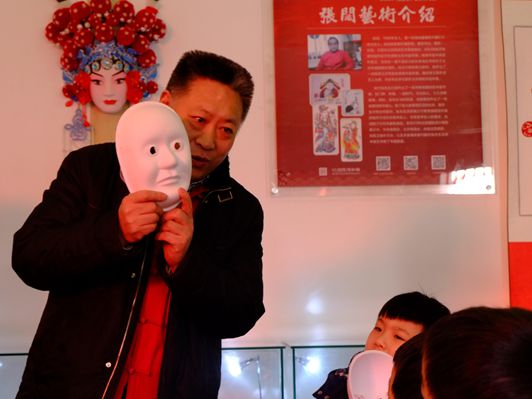
Zhao Yongqi was invited to give an experiencing class to teach how to draw facial masks at Tieshu Xiejie No.9 Museum on February 8 in Beijing. Photo: Sino-US.com
China is conducting an evaluation of the intangible cultural heritage at both national and local levels, and the heritage at both levels needs to be protected and promoted. Some of these are even on the verge of extinction.
Facial Make-up (or lianpu) in Peking Opera, an intangible cultural heritage at local level, is facing difficulties in continuing its tradition, even though it has won some popularity among the young people since China’s reform and opening-up.
Zhao Yongqi, one of the members of Chinese Folk Literature and Art Society as well as one of the inheritors of lianpu, talked to sino-us.com in his studio in Tongzhou district of Beijing about some of the behind-the-scene stories of lianpu as well as his endeavor to protect and carry on this art.
Convergence of lianpu and Peking Opera
Although the legend of lianpu varies, many believe that it was born as a kind of painting on masks often used in tribal rituals, also known as Nuo Opera, to drive away the evil spirits.
The appearance of the first lianpu, though still to be proved, can be traced back to the Northern and Southern Dynasties (about 1500 years ago). To praise and commemorate the military exploits and virtue of Lan Lingwang, a general of that time, people used to perform dances while wearing masks with paintings which could vividly show his personality.
Gradually, as masks with paintings became widely used in traditional Chinese rituals and some local operas, people began to feel inconvenient and to find it difficult to make facial expressions during the performance with a mask on the face. This resulted in painting colors directly on actors’ faces.
Traditional Chinese operas had big impact on the development of lianpu, and the method of painting the face varied in different local operas. Lianpu of Peking Opera has been known as the most popular among all the other local lianpu since Qing Dynasty, as Peking Opera gradually became the mainstream recreation in the Imperial Palace.
There are several genres in Peking Opera lianpu, named after some of the most famous Peking Opera actors. And some cases, the drawing patterns have to be followed in accordance with the shape of the actor’s face.
“Unless the drawing patterns are followed, it will never be called Peking Opera lianpu. For Peking Opera lianpu, the difference between a good painting and a bad painting lies in the position of the eyebrows and eyes which depend on the shape of the actor’s face,” said Zhao.
While specializing in Qian (Qian Jinfu) genre of lianpu, Zhao can also draw lianpu of other genres such as Hao, (HaoShouchen), Hou (Hou Xirui), Jin (Jin Shaoshan) and so on.
“But the lianpu derived from Qian is the best of all. All others were the followers of Qian,” he said.
Painting skills of Peking Opera lianpu changed and developed as the drawing devices improved and people’s appetite towards art and beauty changed. However, the very nature of Peking Opera lianpu never changed. And this has something to do with the somehow unchangeable use of colors in lianpu and the personalities they represent in Peking Opera.
For example, the lianpu of Bao Gong, a judge character in Peking Opera known not only for his tough anti-graft measures but also the typical crescent on his forehead, did not have the crescent at first. Yet, the lianpu for his character has always been painted with black color.
And sometimes, some of the colors carry the same meaning in Peking Opera.
“Every color has its own meaning, but the blue face and the green face represent the same feature,” Zhao said.
 |
| Touched | Sympathetic | Bored | Angry | Amused | Sad | Happy | No comment |
Rhythm Media Group is a multi-media company, operating a US-based Chinese daily newspaper, The China Press, and the paper's website - uschinapress.com (which has mobile-app version), as well as a Beijing-based English website Sino-US.com. The group boasts 15 branch offices across the US, and a number of cultural centers focusing on culture-related business in the North America, Chinese mainland, Hong Kong and Taiwan.Launched in September 2012, the Sino-US.com is designed to serve as a bridge between China and the US, and to keep its readership inside or outside China better informed by providing news and insights on China's current affairs, culture, life, business, people and sports.
|
|